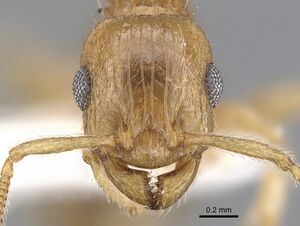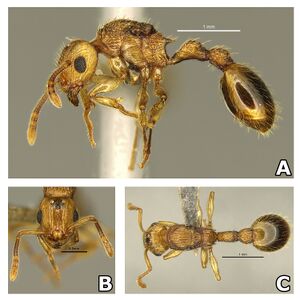Rotastruma stenoceps
| Rotastruma stenoceps | |
|---|---|

| |
| Scientific classification | |
| Kingdom: | Animalia |
| Phylum: | Arthropoda |
| Class: | Insecta |
| Order: | Hymenoptera |
| Family: | Formicidae |
| Subfamily: | Myrmicinae |
| Tribe: | Crematogastrini |
| Genus: | Rotastruma |
| Species: | R. stenoceps |
| Binomial name | |
| Rotastruma stenoceps Bolton, 1991 | |
Very little is known of the ecology of Rotastruma. Luo & Guénard (2016) found a specimen of this species walking on a railing adjacent to a hiking trail at approximate 21:00 h. The surrounding area of the hiking trail is a monoculture plantation of the tree Lophostemon confertus Wilson & Waterh. Whether or not R. stenoceps is actually nocturnal is unknown at this point because the female may have performed a nuptial flight earlier in the day and could have been looking for a suitable location to start a colony.
Identification
This species is similar to Rotastruma epispina, but can be distinguished by the posteriorly directed propodeal spines and short petiolar peduncle (Hosoishi et al., 2021).
Luo and Guénard (2016) - Queen This specimen is distinct from Rotastruma recava and is similar to R. stenoceps due to the following features: lack of concave occipital margin, sides of head with projecting hairs, relatively straight propodeal spines and propodeal spiracle near the metapleural gland bulla.
Hosoishi et al. (2021) note that Luo and Guénard (2016) mentioned that “In full face view, head rectangular in shape, slightly wider than long (CI 85)” in the description of a single queen. However, the CI index and their image (fig. 10B) suggest that the queen has a longer head. The R. stenoceps queen is similar to the R. epispina queen, but can be distinguished by the downcurved propodeal spine and short petiolar peduncle.
Keys including this Species
Distribution
Rotastruma stenoceps is known from Hong Kong and the following Chinese provinces: Guangdong, Hubei, Hunan and Yunnan (Luo & Guénard, 2016).
Latitudinal Distribution Pattern
Latitudinal Range: 22.279139° to 22.279139°.
| North Temperate |
North Subtropical |
Tropical | South Subtropical |
South Temperate |
- Source: AntMaps
Distribution based on Regional Taxon Lists
Palaearctic Region: China (type locality).
Distribution based on AntMaps
Distribution based on AntWeb specimens
Check data from AntWeb
Countries Occupied
| Number of countries occupied by this species based on AntWiki Regional Taxon Lists. In general, fewer countries occupied indicates a narrower range, while more countries indicates a more widespread species. |

|
Estimated Abundance
| Relative abundance based on number of AntMaps records per species (this species within the purple bar). Fewer records (to the left) indicates a less abundant/encountered species while more records (to the right) indicates more abundant/encountered species. |

|
Biology
Castes
Worker
Images from AntWeb
   
| |
| Holotype of Rotastruma stenoceps. Worker. Specimen code casent0901994. Photographer Will Ericson, uploaded by California Academy of Sciences. | Owned by NHMUK, London, UK. |
Queen

| |
| . | |
Nomenclature
The following information is derived from Barry Bolton's Online Catalogue of the Ants of the World.
- stenoceps. Rotastruma stenoceps Bolton, 1991: 9, figs. 13, 15 (w.) CHINA (Guangdong).
- Type-material: holotype worker.
- Type-locality: China: Guangdong Prov., Ding-Hu Mts, 60 km. W Guangzhou, vi.1983 (Z. Bouček) .
- Type-depository: BMNH.
- Luo & Guénard, 2017: 12 (q.).
- Status as species: Bolton, 1995b: 382; Guénard & Dunn, 2012: 52; Luo & Guénard, 2017: 12.
- Distribution: China.
Unless otherwise noted the text for the remainder of this section is reported from the publication that includes the original description.
Description
Worker
Holotype. TL 3.7, HL 0.82, HW 0.68, CI 83, SL 0.56, SI 82, PW 0.48, AL 0.92. Maximum diameter of eye 0.22 (0.32 x HW). Answering the description of Rotastruma recava but lacking its concave occipital margin. Sides of head behind eyes with projecting hairs in stenoceps but hairs absent in front of the occipital corners in recava. Propodeal spines of stenoceps shorter and less downcurved than in recava, and its propodeal spiracle closer to the apex of the metapleural gland bulla.
Queen
Luo and Guénard (2016) - HL 0.72 mm; HW 0.85 mm; MaL 0.41 mm; SL 0.59 mm; EL 0.25 mm; WL 1.21 mm; PNW 0.62 mm; PNH 0.48 mm; MW 0.56 mm; SPL 0.31 mm; PTL 0.61 mm; PTW 0.28 mm; PTH 0.31 mm; TL 4.33 mm; PPL 0.31 mm; PPW 0.28 mm; PPH 0.30 mm; CI 85; SI 81; MaI 56; PI 46; PPI 118
Head. In full face view, head rectangular in shape, slightly wider than long (CI 85). Posterior margin of head straight and posterior corners of head rounded as in worker (see figure 15 in Bolton 1991). Sides of head straight and parallel. Eyes large, in the longest dimension with a dozen ommatidia. Median ocellus level with the posterior margin of the compound eye. Frontal carinae extending to the occipital margin. Mandibles triangular, masticatory region of mandibles with 6 teeth. Antenna with 12 segments and terminated with a 3-segmented club.
Mesosoma. In profile view, dorsum of mesonotum broadly rounded. Propodeal spiracle round and near the anterior margin of the metapleural gland bulla. Wing scars clearly visible. Propodeal spines slightly downcurved, almost straight, apically acute, and marginally extending beyond the propodeal lobes. In dorsal view, mesosoma longer than wide, with anterior margin longer than the posterior margin.
Metasoma. In profile view, petiole pendunculate with an ill-defined node, postpetiole roughly square in shape. A small denticle is present on the ventral side of the penducle, located near the propodeum. In dorsal view, petiole rectangular in shape, and postpetiole trapzedoidal in shape, with anterior margin of postpetiole shorter than the posterior margin. No sting visible.
Sculpture. Cuticle thick, all surfaces except for the antenna, legs, penduncle and gaster sculp-tured. Frons with distinct parallel lines of sculpture. In profile view, sides of mesosoma laterally costate. In dorsal view, scutum and scutellum laterally costate, petiole and postpetiole rugose to rugose-reticulate. Ventral sides of peduncle conspicuously smooth First gastral tergite smooth, with some short basigastral costulae.
Pubescence. All dorsal surfaces of head, mesosoma and metasoma with short sub-erect, apically acute hairs, gold in colour. Antenna with abundant hair, oriented to the apex. Coxa, femur and tibia covered in short suberect hairs, oriented towards the tarsus. Subpostpetiolar process with a few thin erect hairs.
Colouration. Whole body a uniform golden-brown colour, mandibles slightly darker in colou-ration. Gaster darker, light-brown.
Type Material
Holotype worker, China: Guangdong, DingHu Mts, 60 km W. of Guangzhou, vi.1983 (Z. Boucek) (The Natural History Museum).
Hosoishi et al. (2021): Holotype worker image examined.
- Holotype: China • worker; Guangdong, Ding-Hu, Mts. 60 km W. of Guangzhou; Jun 1983; Z. Boucek leg.; type image CASENT0901994 of AntWeb (http://www. antweb.org/); BMNH.
References
- Bolton, B. 1991. New myrmicine genera from the Oriental Region (Hymenoptera: Formicidae). Syst. Entomol. 16: 1-13. (page 9, figs. 13,, 15 worker described)
- Brassard, F., Leong, C.-M., Chan, H.-H., Guénard, B. 2021. High diversity in urban areas: How comprehensive sampling reveals high ant species richness within one of the most urbanized regions of the world. Diversity 13, 358 (doi:10.3390/d13080358).
- Hosoishi, S., Yamane, S., Sokh, H. 2021. A third species of the rare ant genus Rotastruma (Hymenoptera, Formicidae) from Cambodia, with illustrated generic diagnoses and key to species. Deutsche Entomologische Zeitschrift 68, 225–233 (doi:10.3897/dez.68.63478).
- Liu, C., Fischer, G., Hita Garcia, F., Yamane, S., Liu, Q., Peng, Y.Q., Economo, E.P., Guénard, B., Pierce, N.E. 2020. Ants of the Hengduan Mountains: a new altitudinal survey and updated checklist for Yunnan Province highlight an understudied insect biodiversity hotspot. ZooKeys 978, 1–171 (doi:10.3897/zookeys.978.55767).
- Luo, Y.Y., Guénard, B. 2016. Descriptions of a new species and the gyne in the rarely collected arboreal genera Paratopula and Rotastruma (Hymenopytera: Formicidae) from Hong Kong, with a discussion on their ecology. Asian Myrmecology 8: 1-16 (DOI:10.20362/am.008016).
References based on Global Ant Biodiversity Informatics
- Bolton B. 1991. New myrmicine genera from the Oriental Region (Hymenoptera: Formicidae). Systematic Entomology 16:1-13.
- Fellowes J. R., M. W. N. Lau, D. Dudgeon, G. T. Reels, G. W. J. Ades, G. J. Carey, B. P. L. Chan, R. C. Kendrick, L. K. Shing, M. R. Leven, K. D. P. Wilson, and Y. Y. Tung. 2002. Wild animals to watch: terrestrial and freshwater fauna of concervation concern in Hong Kong. Memoirs of the Hong Kong Natural History Society 25: 123-160.
- Guénard B., and R. R. Dunn. 2012. A checklist of the ants of China. Zootaxa 3558: 1-77.
- Huang Jian-hua, and Zhou Shan-yi. 2007. Checklist of Family Formicidae of China - Myrmicinae (Part III). (Insecta; Hymenoptera). Journal of Guangxi normal University: Natural Science Edition 25(3): 88-96.
- Luo Y. Y., and B. Guenard. 2016. Descriptions of a new species and the gyne in the rarely collected arboreal genera Paratopula and Rotastruma (Hymenopytera: Formicidae) from Hong Kong, with a discussion on their ecology. Asian Myrmecology 8: 1-16. DOI: 10.20362/am.008016
- Xu Z. 1999. [An analysis on the ant fauna of the tropical rain forest in Xishuangbanna of China.] Zoological Research 20: 379-384.

